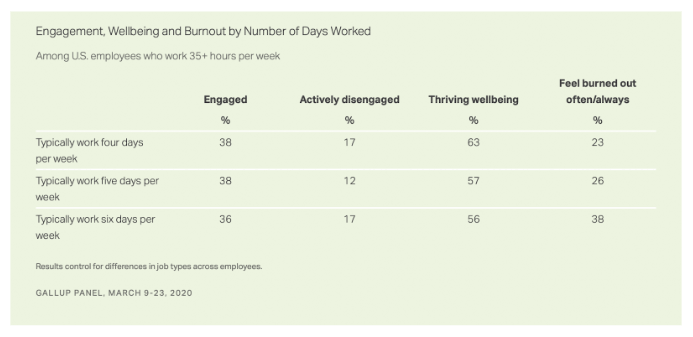In this month’s blog, I explore the 4-day work week. HR websites are full of stories advocating for a shift to a reduced working week, but is it the game-changer promised or just another one of those fads that many organizations won’t ever consider implementing?
In March 2020 when we naively expected COVID to pass by in a few weeks, Gallup reported that 5% of people worked a 4-day week.
Since then, our world has been disrupted more than we have ever experienced as a generation. We’ve dealt with homeschooling, experienced Zoom fatigue and seen a significant increase in reported mental health cases due to the layering of a complex set of factors including precarious employment, concern about our physical safety and social inequality.
So is the simple solution to work less? In their research, Gallup reported a stark difference in the number of people who reported feeling burned out based on the number of days worked.
38% of the 6-dayers reported feeling burned out “often” or “always” compared to 23% of those who were working 4-days – a significant difference.
The benefits of a 4-day week
Beyond personal well-being, the 4-day advocates (and there are many) point to a range of other benefits of disrupting a way of working that many date back to 1926 and the Ford Motor Company.
In the book 4 Day Week, the author shares his experiences of transitioning to a 30-hour week and outlines a number of benefits including better workplace dynamics. Research by Henley Business School, reported improvements in the ability to attract and retain talent, increased employee satisfaction, lower sickness, increased productivity and much-needed environmental benefits. In fact, their research estimates that a four-day week could save UK businesses alone an estimated £104 billion annually.

Source: 4dayweek.com
In Belgium, such is their confidence in the advantages of reducing the working week, they are in the process of introducing new legislation that gives workers the option to choose a 4-day work week in addition to the right to disconnect as we have in parts of Canada (for real not the April Fool doing the rounds!).
Why now?
So why is there such interest in what they call in The 4 Day Week a “flexible work revolution”? They provide a simplistic and linear case based on an escalation of deteriorating worker conditions and a lack of security where workers are consistently abused. For many, the reasons are more nuanced. For instance, the opportunity we have had to experience greater flexibility in our lives and the gift of time that we have used to reinvigorate our hobbies, our relationships and ourselves.
Regardless of the origins of a shorter workweek, it’s a popular manifesto with 92% of US employees reporting that they would embrace the reduction in weekly hours.
So why the apparent apathy from the organization?
With such a compelling business case, new legislation being drafted and many high profile pilots (including Microsoft Japan, Unilever in New Zealand and a 4-year pilot representing 1% of the working population of Iceland), why aren’t more organizations introducing this new practice?
Well, perhaps they are. In Canada for example, research from Indeed identified that 41 percent of employers are thinking about introducing a 4-day work week following the COVID-19 pandemic.
This is counter to my own experience advising a broad range of companies on their new ways of working arrangements where, disappointingly, the 4-day work week has not been on the agenda.
And while it’s exciting to see some smaller HR consulting firms introduce the new approach (for example PTHR and a pilot at The Roundtable), is this game-changing way of working going to hit the big time and be introduced across bigger organizations?
The most productive person in HR
Early in my career, as a bright-eyed HR Manager I worked with, let’s call her Julia. Julia was a working Mum with two young sons who worked a 4-day week and term time only. She was also the most productive person in the HR team.
Julia was respectfully ruthless in her time management and was able to engage in just enough chit-chat at the water cooler to make her popular with colleagues without wasting time. She was organized. An effective delegator and a fantastic communicator. We always knew what Julia was up to, what she needed and when she was next in the office.
Working alongside Julia taught me the value of flexible work both as a HR and a team leader. During my career, I introduced many successful flexible working strategies and had people working for me directly in a vast array of arrangements including part-time, term time only, compressed working weeks and job shares. And they all worked very effectively both for me, the company and more importantly the individual who stayed engaged.
Flexibility is key
The key element was flexibility, and not just in terms of when work gets done, but also where and how. Gallup research tells us that those people who work remotely between 60% and 80% of the week are the most engaged of all workers who have the privilege of being able to spend time out of the office.
Perhaps most importantly when it comes to flexibility, being in control of what we do is a big motivation driver as made identified by Dan Pink’s 2009 TED talk. In fact, research from Effectory shows that autonomous employees are 79% more engaged in their work compared to employees who lack autonomy.
It is worth noting that those clever folks at Gallup report that despite the high levels of well-being amongst the 4-dayers, this population also has the highest proportion of actively disengaged folks when compared to those people working 5 and the same as those working 6 days. There are also many stories of people who accept the trade-off between additional time and increased pressure.

The shortfall in perceived engagement is for a variety of reasons including poor implementation and illustrates the complexity of our relationship with work that makes the 4-day week a potential part of the solution but not the panacea for success that many articles seem to think it is.
How to successfully implement a 4-day week
In The 4 Day Week, the authors provide some helpful advice when it comes to scaling back your working days:
- Be clear on your objectives of the four-day week;
- Fully engage your employees in the process and provide them with the opportunity to shape the approach;
- Keep in mind the individual needs of your team members;
- Avoid top-down decision-making.
It all starts with building trust
I remain optimistic that a full set of flexible work arrangements that include a 4-day work week become a more common and accessible part of what companies offer their employees. Organizations who are considering introducing these arrangements must take a deliberate and holistic approach and avoid seeing a long weekend as the answer to all of their work woes.
The winners in an increasingly competitive market will be the companies who are able to build a culture of trust, flexibility and autonomy – and if you can do that in 4-days that’s even better!


